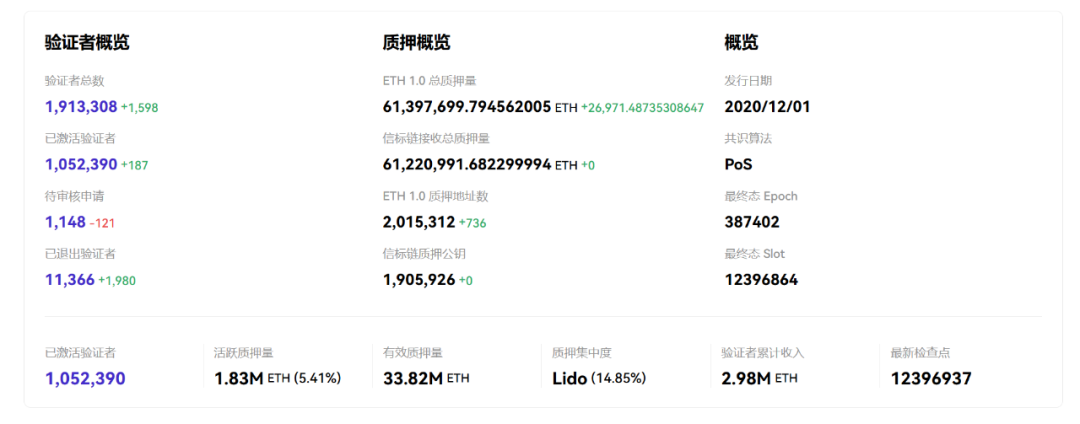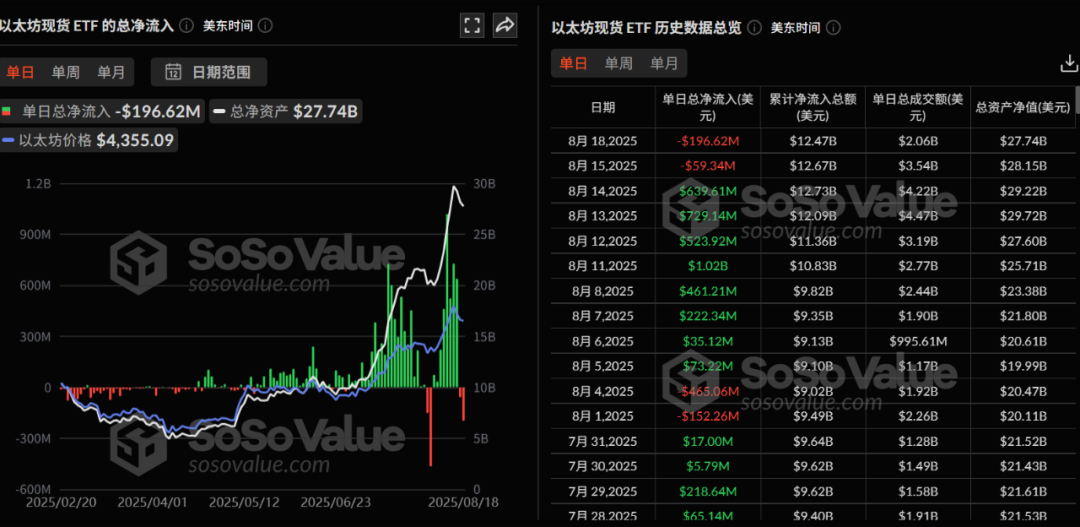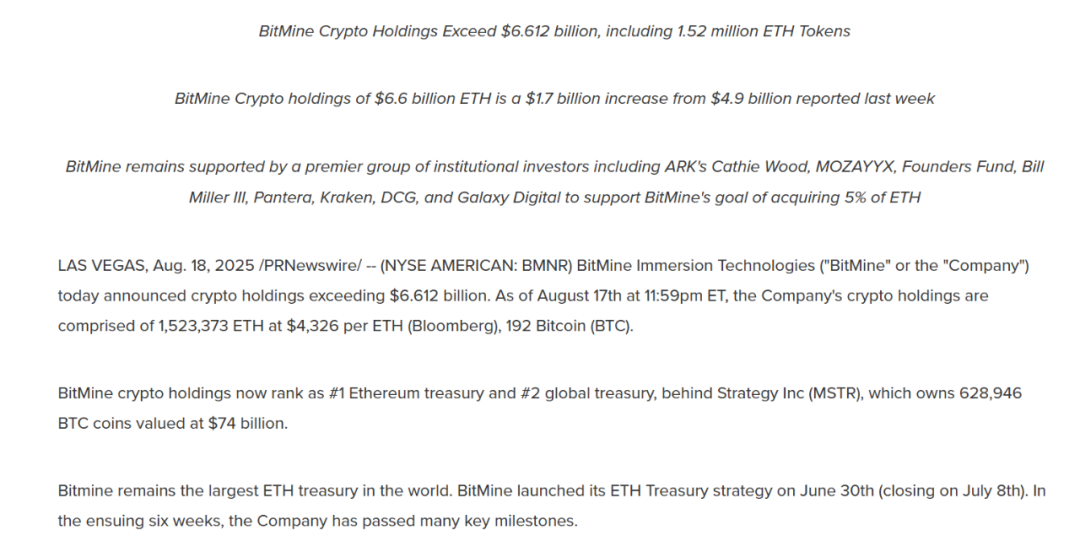Ethereum is standing at an unprecedented "multi-narrative resonance" node.
On-chain, the scale of ETH staking continues to rise, gradually establishing a "risk-free interest rate anchor"; in traditional finance, spot ETFs have been operating for over a year, with trading volume and net inflows rapidly increasing, marking a continuous increase in compliant capital; at the corporate level, more and more publicly listed companies in the U.S. are strategically choosing to include ETH in their treasury reserves.
Staking, ETFs, and corporate treasuries—these three seemingly independent threads are resonating with each other, collectively pushing ETH from a single cryptocurrency to a comprehensive financial asset with yield attributes, compliant channels, and corporate reserve value.
If Bitcoin's story is "digital gold," then Ethereum's narrative is quietly shifting towards "global ledger," and is expected to reach a key "resonance moment" in 2025.
01. Staking Steadily Rising, ETH "Benchmark Interest Rate" Emerges
Since the Shanghai upgrade in April 2023, which opened the staking withdrawal function, Ethereum has completely resolved the dam-like exit risks, unleashing the growth potential of the staking ecosystem. Subsequently, the derivatives market based on LSD has rapidly expanded, driving the ETH staking rate continuously higher.
As of the time of writing, the amount of ETH staked has surpassed 33.8 million, valued at approximately $140 billion at current prices, accounting for over 25% of the total supply, a significant increase from about 10% a few years ago. This not only strengthens network security but also enhances the scarcity of ETH from a supply-demand perspective.

More importantly, ETH staking is gradually becoming the "interest rate anchor" of on-chain finance.
Over the past year, an annualized staking return rate of 3%-5% has been widely accepted by the market, even regarded by some institutional research reports as the "on-chain version of government bond yields," forming an implicit comparison with the U.S. Treasury yield curve. This attribute has transformed ETH from merely a trading asset into one that possesses the underlying logic of fixed-income products.
However, a noteworthy reverse trend has emerged recently—since July 16, the number of ETH unstaking requests has surged, with validator exit requests skyrocketing from fewer than 2,000 to 475,000 by July 22, and the waiting time has extended from under an hour to over 8 days.
According to data from The Block, there are currently about 670,000 ETH (approximately $3.1 billion) in the exit queue, far exceeding new staking demand, with an expected processing time close to 12 days. The main reasons driving a large amount of ETH unstaking include the unwinding of leveraged staking cycles amid rising prices, the risk of LST decoupling, and arbitrage opportunities, with Lido, EthFi, and Coinbase being the primary sources of exits.

Source: The Block
Although the recent wave of unstaking has caused volatility in the short term, from a long-term perspective, ETH staking has gradually become the "risk-free interest rate anchor" on-chain, becoming one of the underlying financial logics of ETH.
It is worth noting that U.S. Treasury yields are expected to remain in the 4%-5% range in 2024, which has made ETH staking rates seem less attractive. However, as the Federal Reserve begins to lower interest rates in 2025, ETH's 3%-5% staking yield will regain competitiveness, and in some risk models, it is viewed as "excess returns."
This indicates that a deeper implicit connection is being established between ETH's on-chain interest rates and the global liquidity environment, especially as re-staking protocols like EigenLayer have absorbed over $10 billion worth of ETH, giving rise to a chain logic of "staking rate → re-staking premium → protocol security."
In other words, ETH is not only an asset in itself but is gradually becoming the underlying collateral of the Web3 financial system.
02. ETFs Become the Main Channel for Traditional Capital
In May 2024, the U.S. SEC approved the 19b-4 applications for 8 Ethereum spot ETFs, which officially began trading on July 23, marking the formal opening of a compliant channel between ETH and Wall Street. To date, Ethereum spot ETFs have been operating for over a year.
Objectively speaking, ETFs, as a "compliance entry point," provide traditional institutions with a direct channel to allocate ETH, while also reducing compliance friction at the financial and auditing levels. According to SoSoValue data, as of now, the total net asset value of U.S. Ethereum spot ETFs has exceeded $27 billion, accounting for approximately 5.34% of Ethereum's market capitalization, with a cumulative net inflow of $12.4 billion since their launch.
However, the market often overestimates the short-term effects of new things while underestimating their long-term impact. The development of ETH spot ETFs is a reflection of this pattern, as the true explosion of ETFs did not manifest from the beginning—prior to May of this year, the average daily trading volume of ETH ETFs remained relatively low, with limited market interest.

Source: SoSoValue
The turning point occurred on August 11, 2025, when the net inflow of Ethereum ETFs exceeded $1 billion for the first time in a single day, with BlackRock's ETHA attracting $640 million and Fidelity's FETH attracting $277 million. The capital siphoning effect of these two giants has become evident, signaling a clear institutional shift towards Ethereum ETFs.
The significance of ETFs lies in the fact that they are not only a "channel" for funds but also a "legal status" on compliance audits and financial statements, greatly reducing the resistance for institutions to hold ETH. Another profound implication is that it opens up arbitrage and allocation paths for cross-border financial institutions.
More importantly, the concentration of ETF holdings has begun to emerge, with BlackRock and Fidelity's ETFs accounting for two-thirds of the U.S. ETH ETF market. This trend towards concentration not only brings about a capital siphoning effect but may also indicate that the "institutional pricing" characteristics of ETH will become increasingly apparent in the future.
03. ETH Accelerates Inflow into U.S. Corporate Balance Sheets
If MicroStrategy is a milestone case for BTC in terms of publicly listed companies incorporating crypto assets into their balance sheets, then starting in 2025, ETH is also迎来类似的转折点.
Recently, an increasing number of U.S. companies have chosen to include ETH in their treasury, and this is not merely symbolic holding but rather large-scale, strategic allocation.
For example, BitMine has disclosed that its crypto asset holdings have exceeded $6.612 billion, an increase of about $1.7 billion compared to the previous week's $4.9 billion, with BitMine holding 1.523 million ETH (valued at $4,326 each at current prices) and also holding 192 BTC.

Source: BitMine
At the same time, Nasdaq-listed company Cosmos Health has also announced a securities purchase agreement with a U.S. institutional investor for up to $300 million to initiate an ETH treasury strategy, providing custody and staking infrastructure through BitGo Trust.
This proactive trend of incorporating ETH into treasuries differs from the passive allocation of ETFs: ETFs primarily carry the exposure demand of financial products, while companies directly purchasing ETH and incorporating it into their treasuries means that ETH is becoming an actual medium of settlement and reserve asset. Whether for financial diversification, cross-border payments, or employee incentives and R&D incentives, ETH is beginning to demonstrate its potential as a "liquid asset."
Overall, after experiencing a wave of widespread pessimism, Ethereum's multiple narratives are forming a synergy:
- Staking yields have brought ETH a "government bond-like" interest rate anchor;
- ETFs have opened up channels for compliant capital allocation;
- Corporate treasuries further endow ETH with real value for reserves and payments;
These three intertwine, collectively driving ETH from a "cryptocurrency" to a "financial infrastructure asset."
If Bitcoin represents "digital gold" in corporate treasuries, then Ethereum's value narrative is gradually pointing towards the "liquidity core of the global ledger."
免责声明:本文章仅代表作者个人观点,不代表本平台的立场和观点。本文章仅供信息分享,不构成对任何人的任何投资建议。用户与作者之间的任何争议,与本平台无关。如网页中刊载的文章或图片涉及侵权,请提供相关的权利证明和身份证明发送邮件到support@aicoin.com,本平台相关工作人员将会进行核查。




